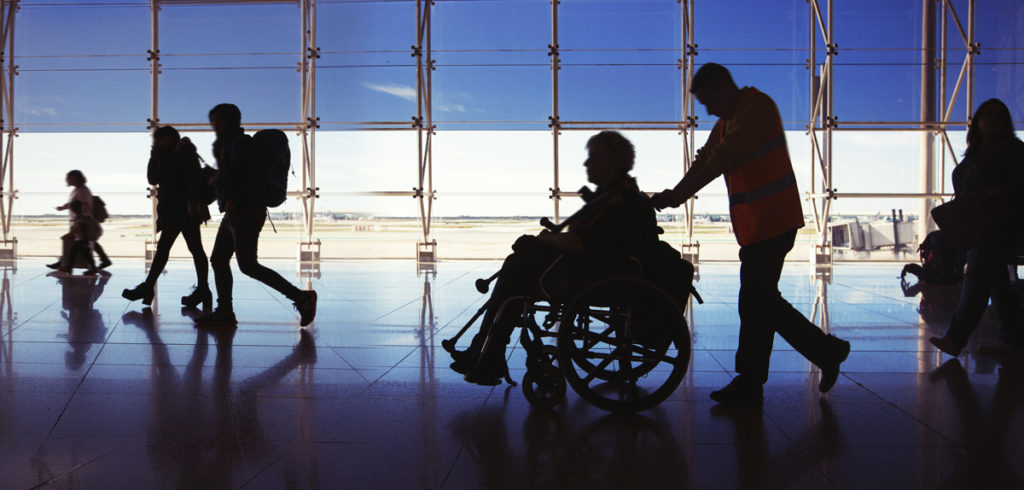The airport experience for those requiring assistance is in many respects significantly worse than for the majority of travelers. David Watts, managing director of CCD Design & Ergonomics, highlights how airports can better accommodate the needs and preferences of those with disabilities.
When it comes to flying, most of us assume that we will be able to explore the airport, check out some shops and have a coffee while waiting to board our flight.
But what if you were visually impaired? Or, if you were a wheelchair user or had a temporary disability, such as a broken leg? What if your overall experience in the airport depended on being assisted? Would it be quite so leisurely or straightforward?
According to The Independent newspaper, over 200 million people flew in and out of the UK last year, but only 36% of people with a disability took a flight. This suggests that disabled travelers still perceive barriers when it comes to flying.
Although airports have a legal obligation under EU Regulation 1107/2006 to assist disabled travelers (in the UK this is regulated by the CAA), customer feedback regarding assistance services is almost universally poor when compared with the experience provided to other passengers. While some passengers with a disability have enjoyed the service received, many others have claimed to feel they were treated as objects rather than humans and have even been put off flying as a result.
It is a service with an interesting model: the booking is made with the airline although the majority of the service is provided by the airport, almost always through an outsourced provider. As a result, as well as the logistical challenge, this is a service of limited financial benefit to the various businesses involved.
Booking assistance: room for improvement
Based on our experience of inclusive design at airports and having an associate, Emily, who is a wheelchair user, we want to look across this assisted passenger journey and see what opportunities there might be for improvement.
The first step is booking the service online through the airline. The passenger is asked lots of questions about the help they will need, but these are usually structured in a way that is service-delivery orientated rather than customer-centric. For example, Emily is asked questions about the size and weight of her wheelchair (which is perfectly reasonable) but nothing about the kind of support she needs, and where and when it will be required. This reflects the general ‘one size fits all’ service model.
In addition, there is no option to save these answers, so a frequent flyer like Emily has to answer the same questions every time she flies. While this is beneficial for a traveler with a temporary impairment, or a condition that fluctuates in severity, it can feel unnecessary, intrusive and repetitive for those who don’t.
After the passenger has ‘requested’ assistance through the airline, they may get very little in the way of confirmation that their assistance has been booked, or information on what to do next. This may make them more anxious about the journey.
At the airport
Once at the airport, where staff often know little about the passenger beyond an initial categorization of the level of assistance required, the disabled traveler is once again pushed into a one-dimensional service and has to repeat their explanation of the assistance required to the various agents they meet along the way.
Assistance is usually built around the agents moving the traveler through the airport and may entail a series of waits for the former to collect the latter at ‘host areas’ – first landslide, then airside, then finally at the gate. In many airports these are often unloved spaces with some seats fenced off by tensator barriers, with the news on a TV if the traveler is lucky. They might be near F&B outlets or by an accessible toilet but again, this is not always the case. While the rest of us are enjoying retail therapy or a few beers, passengers using the assistance service are left waiting with little in the form of refreshment or entertainment. Such a difference could be made by adding choice and autonomy to this otherwise strict and, frankly, unfair structure. How might we use existing technologies to enable the passenger and agent to meet up in a more flexible way?
What about security? No-one enjoys security, but there is extra stress for those who require assistance. They may be slower and they may need more time. The traveler and their equipment may well be searched and tested numerous times if, like our associate Emily, they are a wheelchair user or have other aids and devices. During this search, meanwhile, the traveler’s valuables and belongings are at the other end of the conveyor. A number of disabled passengers we’ve worked with have described the extra stress this adds to the journey. How might we reduce the additional stress caused by security?

On the aircraft: the anxiety continues
The passenger journey continues with boarding, usually following a ‘first on, last off’ format for disabled travelers, assuming, of course, that staff arrive on time and with the correct boarding equipment, be this an ambulift or a hoist. As noted earlier, this service relies on human agents walking around the airport, so delivering an on-time, just-in-time service is a challenge. There is also often no easy way for the traveler to opt out of the service and take care of themselves.
Once on the plane, the traveler can relax and hopefully enjoy the flight, but for those traveling with equipment, arrival may be the most stressful part of the journey. Now dealing with a different airport in a different country, passengers may be left wondering whether someone will be there to greet them and, most critically, whether their wheelchair or equipment made it onto the plane, and off it again, in one piece. How might we reassure the traveler?
Looking ahead
The current service model is stressful, and the experience is a long way from what is wanted, both by passengers and by the airports and airlines striving to be inclusive. Design thinking and service design methods can bring new perspectives and approaches to the challenge by focusing on the problem from the correct, customer-centric starting point and by considering the importance of social accessibility as well as the role of physical and the digital elements.
It is time to rethink this crucial service. In its current form it disenfranchises and isolates passengers with disabilities, leaving them feeling less valued and more vulnerable than their non-disabled peers. We must create a customer-centric service that can adapt to the needs of individuals, delivering a genuinely human service and the freedom to travel – for all.
Learn more at the Aging Population & PRMs stream at this year’s Passenger Terminal CONFERENCE. The full conference program can be found here.

